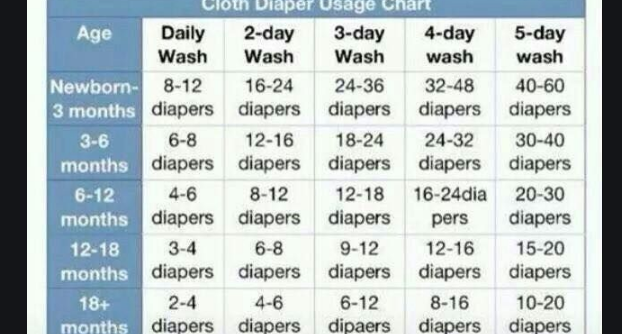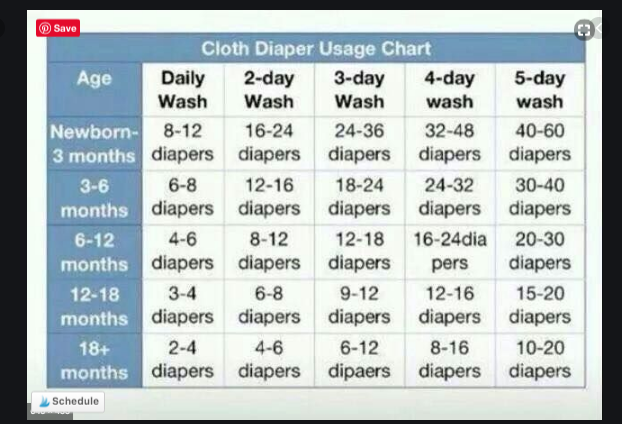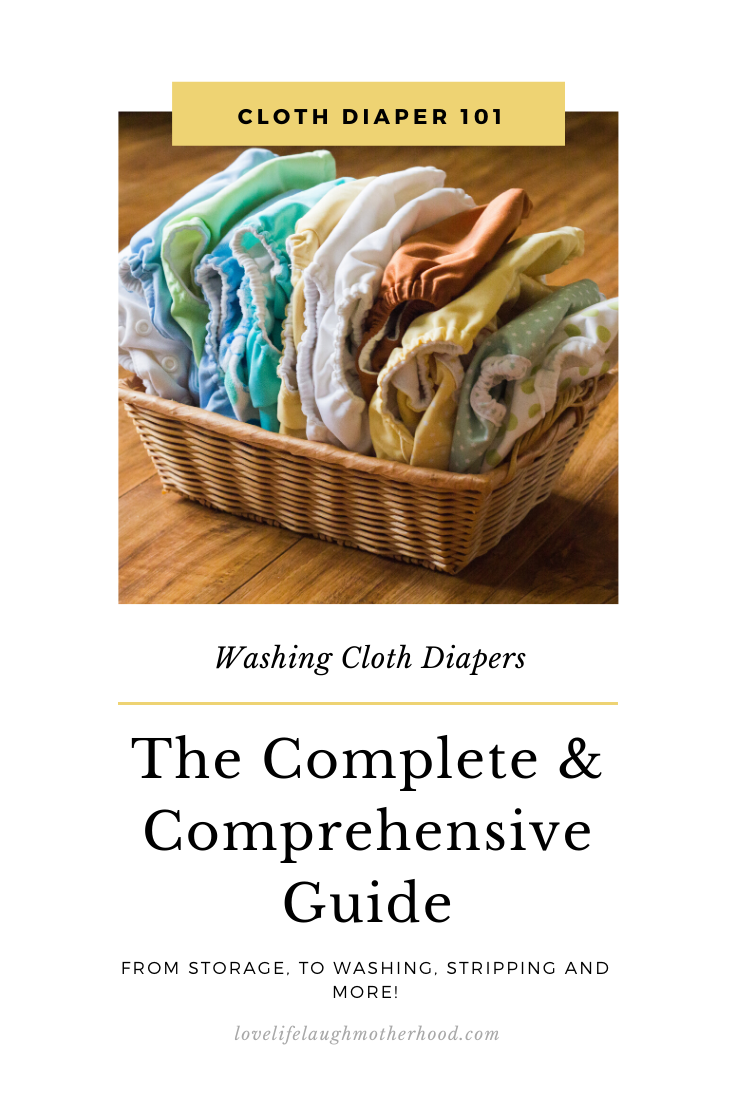
Washing Cloth Diapers: The Complete Comprehensive Guide
So you’ve chosen to cloth diaper your baby. The first question you ask yourself is, how to do you wash your beautiful, fluffy, adorable, cute diapers that you invested in to keep them looking like they did when you first bought them?
This is a guest post that contains affiliate links.
The number one reason why parents want to RUN far away from cloth diapers is because of the idea of WASHING them.
I get it. I mean, who the heck wants to have to deal with any more poop when changing diapers than they have to, right?
But the fact is, washing cloth diapers is actually just a part of cloth diapering!
The ENTIRE reason you are using cloth diapers is to be able to REUSE them. So it goes without saying, you need to wash them if you choose to use cloth diapers.
Decisions Decisions! You want to cloth diaper ONLY because you are 100% okay with washing them.
Want to know Jasmine's reasons for cloth diapering? Check this out!
If washing cloth diapers scare you away, just HANG ON! Don’t run yet! Let me explain to you why this really NO BIG DEAL!
It is really so simple and you never have to touch what you think you have to touch.
GUYS! With 9 years of cloth diapering experience, washing cloth diapers is super EASY with a capital E!
Today I will discuss all of the basics you need to know about washing cloth diapers:
- Supplies you need to wash cloth diapers.
- What to do with your soiled/wet diapers after changing.
- The actual wash routine.
- How to dry them.
- What to do if you have hard or soft water.
- Washing machines.
- Stripping
- My personal routine for Southern Comfort Fitteds
But First…
Everyone will have their own personal touch of how they want to wash diapers.
*DISCLAIMER* I do not claim to be an expert but my comprehensive research comes from credited sites and companies, as well as my own experiences. This post is just a condensed version of it all so you can curate your own method based on this skeleton model below. This cloth diaper washing routine is good for ANY type or brand of diaper, but I do not take responsibility for anything that goes wrong during your wash routine.
This routine is just for you to take off and go by.
By NO means do you HAVE to wash your cloth diapers this exact way.
But having this list below will make you feel better knowing that it was written by a professional cloth diaper designer with authority in the niche you can trust!
Supplies needed for washing cloth diapers
*affiliate links are added below*
- Diaper Pail (aka trash can). Most importantly you will need a diaper pail for storing dirty diapers between washes. So a tall plastic or stainless steel 13-gallon trash can with a lid. I like this odor controlled stainless steel trash can with a censored open and closing lid. Steel cans will keep the odor down much more effectively.
- Next, large pail liners. These are for lining the diaper pail so you can easily wash your diapers. I love THESE pail liners. They come in a 2 pack for under 30 bucks, Last FOREVER wash after wash. Super durable, sustainable AND can hold a SHIT ton (no pun intended) of dirty diapers.
- Cloth diaper safe detergent. The majority of “green and natural” detergents are DEFINITELY NOT strong enough to clean your diapers thoroughly. And it is simply not true that you have to use a SPECIAL cloth diaper detergent. Absolutely do NOT use fabric softeners. This will adhere a layer to your cloth diaper that prevents them from doing their job, ABSORBING.
So make sure when choosing a detergent that it does NOT have added softeners. Here is a list of STORE brand recommendations highly recommended, liquid or powder) detergent (it is recommended to use a detergent, not a soap):
Tide Original
All Free and Clear (best bang for your buck)
Sun Free and Clear
Tide Free and Gentle
Seventh Generation
Kirkland Environmentally Responsible
Pyrex Naturals
*affiliate links below*
Cloth diaper safe detergent list of I DO NOT RECOMMEND from user experience
(do not use these!)
Rock n Green
Bum Genius
Charlies Soap
Ecos
Ecos Nuts
Soap Berries
Soap Nuts
Charlies
Allens Naturally
Crunchy Clean
A diaper sprayer. Like THIS ONE which is affordable and serves its purpose. An investment well made. (or if your toilet is near the shower and you have a showerhead you don’t need one) to spray dirty diapers. This spray not only keeps the stains away, but it eats up any bacteria
Want to know the 8 worst cloth diapering mistakes? Click here!
How to store dirty diapers
If the diaper is just wet, take the diaper apart by all of its pieces and toss it in the pail.
If you absolutely do NOT want to touch these parts, you can always use these inexpensive, reusable rubber gloves
Even toss those puppies in with the diaper laundry. Separate each part. Spray the diaper down with Bac-Out (an all-natural stain and odor eliminator spray safe for cloth diapers).
Toss inside your diaper pail and shut the lid.
If the diaper is dirty, take it to the toilet and shake, dump the solids into the toilet. Flush.
If the soiled diaper will not dump out, grab your diaper sprayer or shower head and spray it down into the toilet until all solids are sprayed off.
Flush. Spray the diaper down with Bac-Out and toss it inside the diaper pail.
Post Contains Affiliate Links
If you also use cloth wipes, you will wash and store dirty wipes along with your cloth diapers.
When to wash dirty diapers
This all depends on how many cloth diapers you have and how often you are changing your baby. As well as how many babies you are cloth diapering at the time.
If your stash is minimal, you might need to wash every other day
If you have enough cloth diapers to last you about 3 days, then you can wash every 2-3 days. You do not need to stress yourself over hurrying to wash the diapers after sitting there for 24 hours. It is perfectly fine just to grab them when you can.
Here is a chart you can go by for the amount of diapers you would need per baby and how often to wash:

You also want to make sure you aren’t letting them sit any longer than 5 days. You don’t want to end up smelling the diaper pail or letting the bacteria build-up that long.
Let’s Discuss Machines for a Sec
Post contains affiliate links
Depending on your machine size, you only want to fill it about ½ to ⅔ full. You want plenty of water in there to agitate and a good amount of it to get your load clean.
Front loader machines work completely fine for washing cloth diapers. You may need to tweak the settings based on your brand, wash load, settings, etc.
Top loaders machines do seem to work better because there is the center agitator to swish the diapers around inside a pool of water. But don’t let cloth diapers be the reason you buy a specific machine.
Both front and top loaders work just fine for washing cloth diapers.
Need a laugh? Here are the 5 Cloth Diapering Stereotypes, as told by a Cloth Diapering Mom!
NOW! On to the washing method!
It is time to wash your cloth diapers, this is the easy part! You have already done the hard part of preparing them to be washed when you threw them into the pail using the steps above.
Step 1: Open your trash can, grab your liner and pull the drawstring together. Carry the bag to the laundry area.
Step 2: Take your bag and DUMP the cloth diapers into the washing machine. Then throw the wet bag on top right after, push your hand through the bottom of it and flip it inside out.
*SIDE NOTE* I recommend washing cloth diapers FIRST THING in the morning if you plan to line dry, so they can hang in the sun for the entire day. Try to choose a day to wash on a dry, warm sunny day so you can hang up your diapers to dry in the sun all during the day. If not, drying your diapers in the dryer or inside the house on a line will work just fine too.
Washing Method:
Do a cold rinse first. Add a cup of vinegar to this rinse to balance out the ammonia. Sometimes I do another cold rinse. Add your cloth diaper safe detergent and wash on HOT on a heavy-duty setting.
If you have a sanitize mode that works great too. You can also add a cap full of bleach. This amount is not enough to damage your diapers, just enough to kill the bacteria. Do another cold rinse. They are DONE!
Drying Method:
Either: Hang each piece up to dry either in the sun or in a room in the house where the sun will come in through the window on a drying rack or wherever you can. The sun will continue to kill any bacteria and naturally removes any further staining. I like to leave mine hanging for the entire day.
Or: Throw them all in the dryer, but hang up any diapers that have PUL. It is NOT recommended to put PUL diapers into the dryer. This could potentially melt or ruin that kind of fabric. PUL is not meant for a dryer.
BONUS: throw in some homemade dryer balls or THESE for a faster dryer time. Dryer balls separate the diaper parts bouncing them around allowing a faster dry time. You can add lavender essential oils to homemade dryer balls to give your diapers a fresh clean scent. Dryer balls are only optional, not required
At this point, your diapers are clean and DRY!
Just toss all clean diapers into a laundry basket and fold them how you like them. Put them away for ready to use!
Don’t forget to restock the diaper bag!
Soft Water v. Hard Water
Do you have hard water? If so, this can cause a mineral build-up on your diapers, preventing them from getting completely clean. In the same sentence, really soft water can cause your water to over sud and get too frothy.
If you have hard water, you can use an additive like borax to soften it up a bit.
The key is to get your water somewhere in the middle of hard and soft.
Don’t try to over-analyze what kind of water you have. You will be able to tell when you feel like your diapers just aren’t getting as clean as you like.
If you really want to know, you can use these test strips to test your water.
Getting your diapers as clean as you want them may take some tweaking in your wash routine if you have hard or soft water. Over time you will figure out exactly what you need to do after some trial and error.

Stripping and What is it?
If your diapers have a slight ammonia smell even after washing them, it is probably best to strip them.
Personally I’ve only ever stripped my diaper stash ONE time in all of my cloth diapering years.
Sometimes you can strip just to give your diapers a reset.
You can also choose to strip cloth diapers that you buy used from another person for sanitary safety.
How to Strip:
Fill up the bathtub, sink or a large tote with HOT water and 2-4 teaspoons ( i just do a few squirts until i feel it’s enough based on how many diapers I am stripping) of dishwashing detergent and half a cup of bleach.
Or you can add a packet of RLR a natural laundry powder that whitens, brightens and freshens cloth diapers, YAY!
Put your clean WET cloth diapers that you just washed from the washing machine into the above solution.
You do NOT need to put the shells in (mainly PUL shells).
Only the absorbent layers normally need to be stripped. If you strongly feel the shells need to be stripped, just throw the ones in there that you think need to go in too.
Lay them all inside, and swirl them around. I used an old wooden broom hand I had laying around to “hand wash” them.
Let them sit for a few hours or overnight (make sure to keep some diapers out for changing baby until these are done, you can do strip in batches.)
Drain the water, squeeze/ring out the diaper parts.
Carry them back to the washing machine and do another cold rinse. After the rinse is over, choose one of the drying methods above.
At this point, your diapers should be clean as a whistle. You shouldn’t have to strip your diapers more than once or twice in your cloth diapering years.
Want to learn about Bum Genius Diapers? Read this review!
Southern Comfort Fitteds Tried and True Cloth Diaper Washing Routine
These instructions are recommended by the Real Diaper Association (RDA) and Southern Comfort Fitteds. For special circumstances or personalized advice, please contact us at [email protected].
CHANGE baby into a clean, dry diaper as soon as the diaper they are wearing is soiled or feels damp to the touch. It is recommended to use your diapers in 10+ diaper stash rotation. I always use the “change when wet” rule of thumb. Never let baby sit in any diaper (cloth or disposable) after baby has gone potty.
REMOVE SOLIDS Unsnap and separate all parts of the diaper for a more thorough cleaning. Dump, scrape or spray solid waste into the toilet and flush. Store wet/soiled diapers in a dry pail lined with a cloth diaper wet bag/liner with a lid that closes.
WASH Once your diaper laundry is full and ready to wash, put all diapers together in the washing machine and do a cold, regular rinse with no detergent. Make sure there is enough room for the machine to agitate freely.
RINSE When the rinse cycle is over, add a cloth diaper safe detergent best for your family, and wash on heavy-duty with warm/hot water. Do not use fabric softeners. Use as much detergent as you would use on a regular load of laundry.; If you have hard water, you may need to use additional detergent or a water softener.
EXTRA RINSE Once the wash cycle is complete, set the machine to another rinse cycle, no detergent, in warm water.
DRY Dry your diapers by hanging in the natural sunlight or in your dryer on med/high. Sun -drying is great for saving energy and will help remove any unwanted stains directly from your diapers. If you choose to use your dryer, do not use dryer sheets. Fabric softeners create a build-up will cause the natural fibers to lose its absorbency.
So you have cloth diapers, but what about clothes that fit them? Check out this Harem Pant review!
Are you still confused or worried about washing cloth diapers? Comment below and let me know if there are any questions you may have. I am happy to do one on one consulting to help you with any of your cloth diapering needs. You can email me at
Author Bio: Hi! I'm Makayla.Welcome to Southern Comfort Living. I am amom of 4 and married to my best friend for 11 years! With an online business specializing in handmade cloth diapers and more. This blog is dedicated to sharing my lifestyle experiences as a mom, business owner, seamstress, and SERIOUS love for AUTISM. I am an artist at heart and want to share my view of the world with you! I specialize in custom cloth diapers as well as custom clothing for children and women. In the blog I discuss topics such as cloth diapering, sewing, fabric, parenting, organization, productivity, work at home moms/small business, photography, and soon to be blogging and money. A lifestyle blog of sorts.


I had no issues washing my diapers but the microfiber did get a stink to it. I had to strip them every once in a while.
I wish I would’ve seen this when we were in the diaper phase with our kids. I will pass this along to my pregnant friend who mentioned she was interested in cloth diapers.
That is a detailed post on washing and managing the cloth diaper laundry. Cloth diapers are great for the environment as well as for baby’s skin. I recommend cloth diapers too.
Oh my goodness, what an amazing post! I SO could have used this about 6 years ago. We started cloth diapering 10 years ago w/my first because we had a local service that delivered clean diapers each week/took away the dirties. When they abruptly went out of business a year before my youngest was done (their commercial laundry partner closed and they could not find a replacement), I was stuck having to figure all this out for myself, pronto. I didn’t do nearly as good a job as I would have if I’d had this post! Thank you for this great resource!